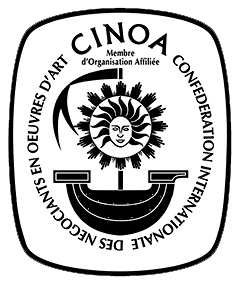On the exterior of this cabinet is a depiction of a story from the Old Testament: the life of Mozes. The central depiction on the left-hand door, carved in low relief, portrays the moment where the baby Moses is found by the Pharaoh’s daughter at the Nile river. As is typical for these cabinets, the carvings are after compositions by masters from all over Europe from earlier ages, that probably reached the maker of this cabinet through novels and etchings. In this case, the carving is after The Finding of Moses (c. 1580), by Italian painter Paolo Veronese.
On the right-hand door is a depiction of Moses Striking the Rock, a scene where the prophet strikes the grounds to draw forth water for the Israelites. This carving is after a composition by Raphael, Moses Strikes the Rock at Horeb, c. 1518. The doors are surrounded by various floral motives, mythological creatures and grotesques, all within fine ripple-moulded frames. On the inside of the exterior doors are depictions of carved flower still-lives enclosed within thick ripple-moulded frames. Floral motives are continuously seen in the decorations of this cabinet, even the hinge-plates are engraved with flowers.
The cabinet opens up to reveal two rows of five drawers, with a wider drawer above and beneath, carved with flower garlands and various other decorations. Two inner doors, carved with mythological scenes, open up to reveal a theatre where a freely standing artwork, such as an ivory sculpture, could be displayed. On the left-hand door is a depiction of Io as a cow. Io was a priestess of the goddess Hera. Zeus, the king of the gods, became infatuated with Io and, to conceal his affair from his wife Hera, he transformed Io into a beautiful white young cow. This carving is after an etch of Crispijn van de Passe of c. 1602 - 1607. The right-hand door portrays the story of Endymion and Diana, specifically the moment where Endymion is being captured for cutting a branch of the myrtle tree that he was tasked to do by an unknown woman that came to him, later appearing to be Sthenobée. Diana punishes Endymion for cutting the tree and will ultimately sacrifice him. The design for this carving is yet again after a design by Crispijn van de Passe, that was probably seen by the maker of this cabinet in the novel ‘l’Endymion’ by Jean Ogier de Gombauld, that first appeared in 1626. Within the theatre is a trompe l’oeuil of inlaid ivory, ebony and rosewood, creating an illusion of depth. Surrounding the central inlaid panel are two rows of five drawers decorated with marquetry and ripple-moulded frames. In the middle is another wider drawer.
The cabinet rests on an open stand with a decorated frieze carved in low relief. In the centre of the frieze is a depiction of a resting faun. Within the frieze are two hidden drawers. The turned legs are probably of ebonized pear-wood. The cabinet is fitted with a pull-out leaf, decorated with marquetry in rectangular shapes.
Ebony cabinets such as this one served as prominent display pieces, showcasing the wealth and influence of their owners while aiming to impress privileged visitors. Beyond their ornamental function, these cabinets also served practical purposes, providing storage for papers, precious items, and exotic curiosities within visible drawers and concealed compartments. They often doubled as a stage for occasional display, with features like caissons or sliding shelves enhancing their versatility. Among the treasures commonly housed in Parisian cabinets were coins, medals, gloves, fans, and various small jewels and curiosities crafted from materials such as oyster or turtle shell, ivory, and silver. Contracts specifically mentioned the importance of the keys, highlighting their role in safeguarding the cabinet's contents and the privacy of its owner. Typically found in lavishly furnished rooms like grand salles or important bedchambers, these cabinets occupied a central place in the aesthetic and functional landscape of elite homes. The undecorated backsides of the cabinets suggest that they stood against a wall.









